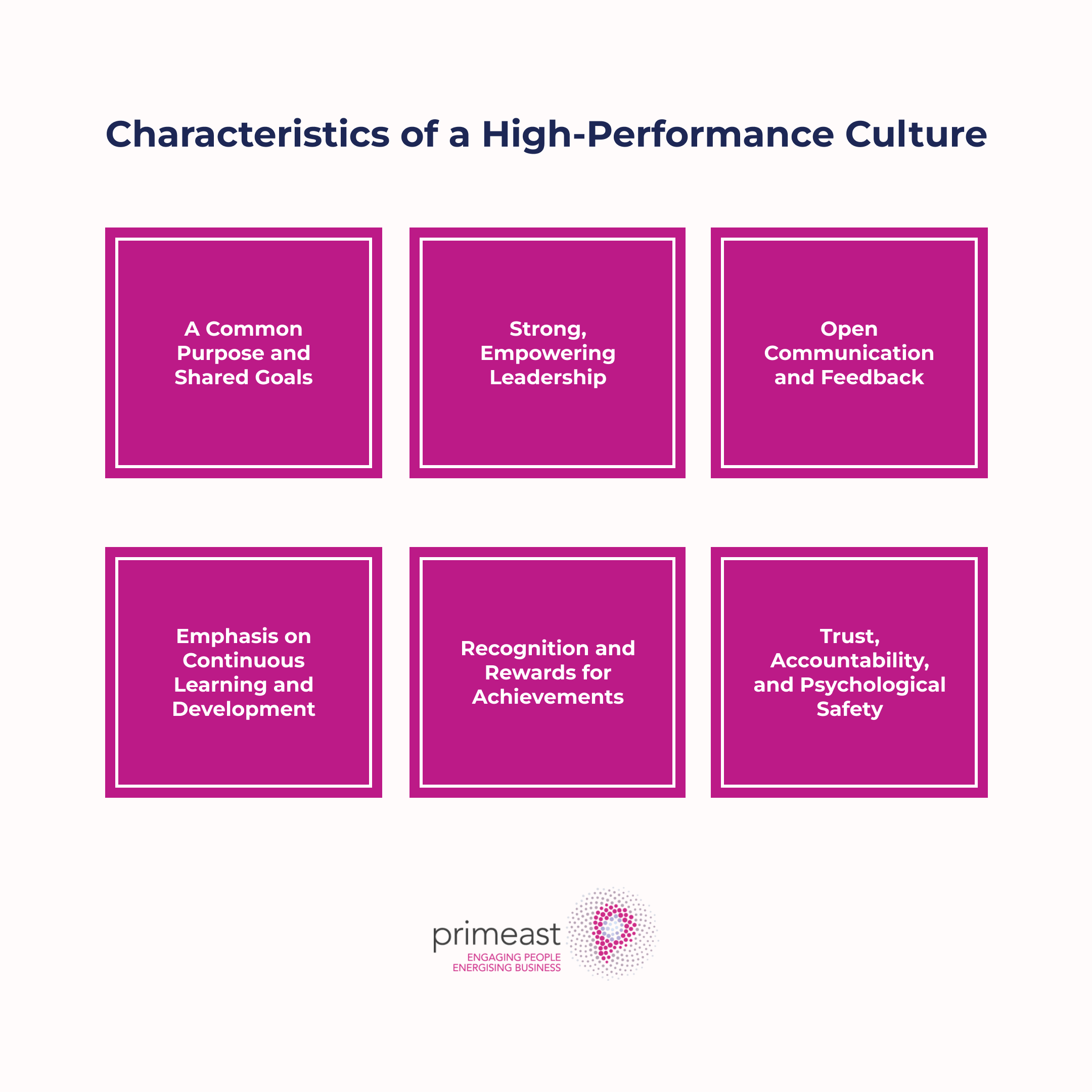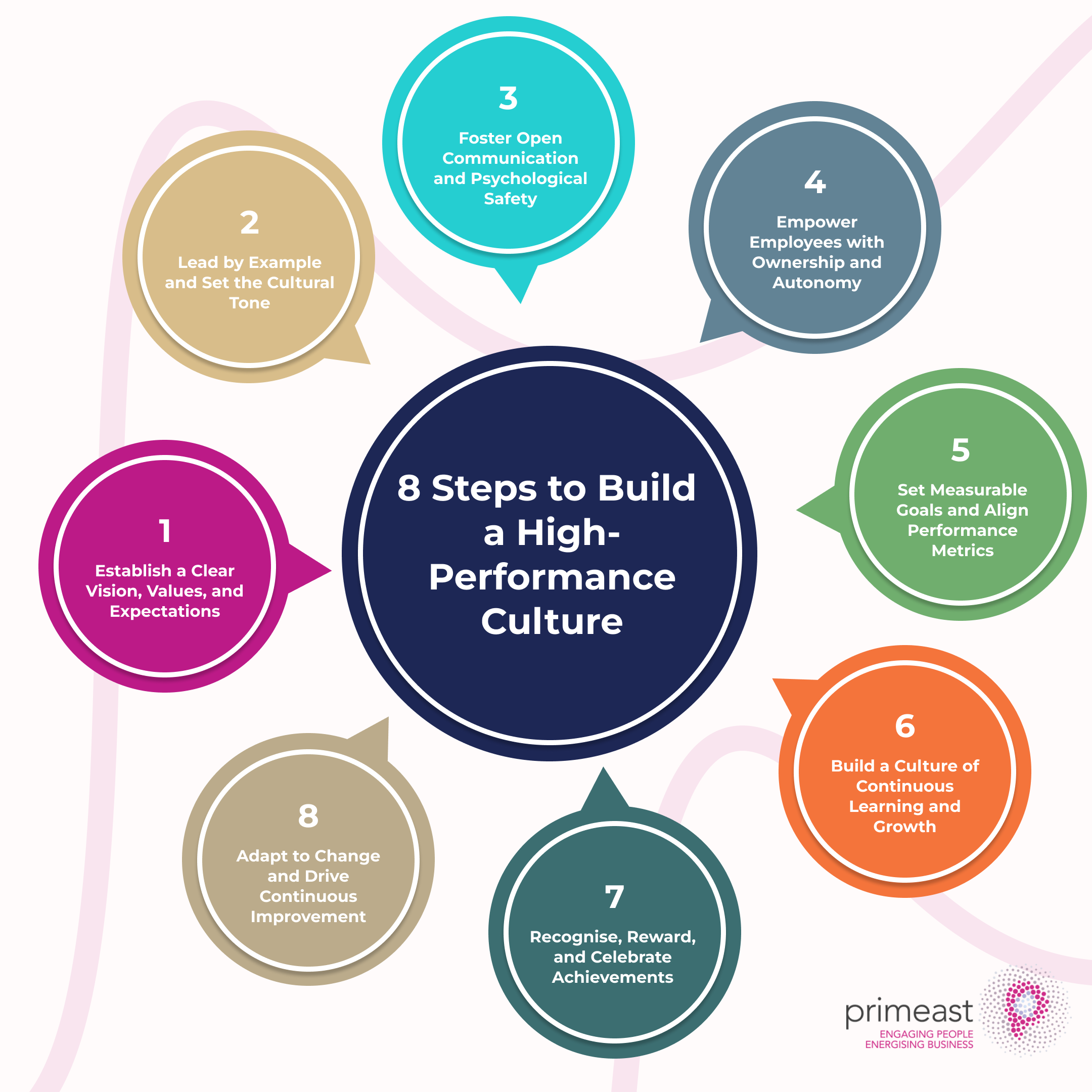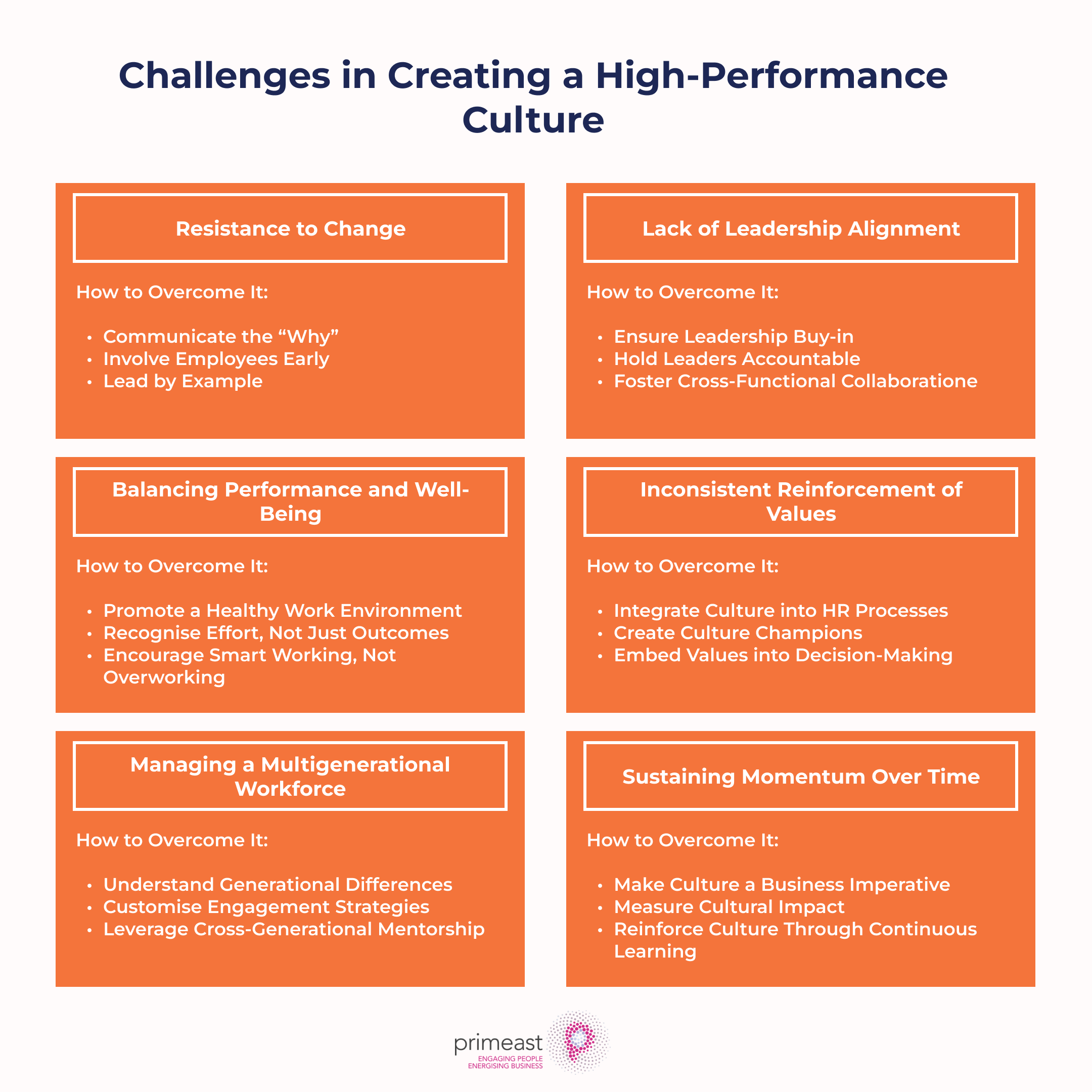
What is a High-performance Culture?
What makes some organizations thrive while others struggle to keep up? The answer often lies not just in strategy or talent but in culture, specifically, a high-performance culture.
A high-performance culture is more than just a buzzword; it’s the foundation that enables businesses to innovate, adapt, and outperform competitors. It’s the invisible force that drives engagement, fuels motivation, and turns employees into purpose-driven contributors. But achieving this doesn’t happen by chance, it requires deliberate leadership, aligned values, and a relentless focus on continuous improvement.
Organizations with a strong performance-driven culture don’t just excel in results, they also attract, motivate, and retain top talent, while readily adapting to change.
Research from Columbia University showed that job satisfaction plays a critical role in reducing employee turnover, and low turnover is directly linked to higher organizational productivity and performance. In fact, the study found that job satisfaction is inversely related to turnover intention, meaning that when employees feel engaged and fulfilled, they are significantly less likely to leave.
The study from Columbia University also highlights how organizational culture acts as a powerful moderator in this relationship. Younger employees, in particular, are more likely to stay when they experience a strong cultural fit. That gives them a feeling of belonging; a sense of doing “good work” while developing and moving forward in their professional career. As the workforce continues to evolve with an aging population and shifting generational expectations, fostering a high-performance culture has never been more crucial for long-term business success.
So, how do you build a culture that enables individuals and teams to excel? What are the key elements that define high performance? And how can leaders embed the right values and behaviors into the DNA of their organization?
In this article, we’ll explore the characteristics of high-performance cultures, the role of leadership, and practical strategies to create a workplace where people thrive, and businesses succeed.
Characteristics of a High-Performance Culture
High-performance cultures don’t happen by accident.
They are carefully shaped, reinforced, and sustained by the behaviors, values, and mindsets of both leaders and employees. While every organization has its own unique DNA, the most successful ones share a set of common characteristics that drive engagement, accountability, and continuous improvement.

A Common Purpose and Shared Goals
A high-performance culture is built on clarity of purpose.
Employees perform at their best when they understand why their work matters and how it contributes to the organization’s mission. When a company’s vision, goals, and values are well-communicated and embraced, teams are more likely to stay aligned, motivated, and committed to collective success.
Leaders should continuously reinforce the company’s purpose through storytelling, recognition, and transparent communication to ensure alignment across all levels.
Strong, Empowering Leadership
Culture starts at the top.
Leaders in high-performing organizations don’t just set expectations, they live and breathe them. They inspire, empower, and create an environment where people feel psychologically safe to take ownership and make decisions.
Leaders should lead by example, demonstrate authenticity, and cultivate trust by providing guidance, removing obstacles, and empowering teams to innovate.
Open Communication and Feedback
A hallmark of high-performance cultures is a two-way communication system where employees feel heard, valued, and encouraged to share ideas. Transparency fosters trust and engagement, while regular feedback loops help drive continuous learning and improvement.
Organizations should promote regular feedback mechanisms (e.g., pulse surveys, open forums, one-to-one check-ins) to ensure communication flows both ways.
Emphasis on Continuous Learning and Development
High-performing teams never stop learning.
These organizations invest in skill development, coaching, and mentorship to ensure employees are constantly evolving and prepared for future challenges. A culture of learning also boosts innovation, adaptability, and employee engagement.
Companies should provide structured learning opportunities, encourage cross-functional collaboration, and recognize employees who actively seek growth.
Recognition and Rewards for Achievements
People thrive when their efforts are recognized.
High-performance cultures create systems to celebrate both big wins and small victories, reinforcing desired behaviors and motivating employees to go above and beyond. Recognition can be formal (bonuses, promotions) or informal (peer appreciation, public praise).
A structured recognition programme (e.g., Employee of the Month, peer-to-peer recognition platforms, milestone celebrations) can go a long way in reinforcing a culture of excellence.
Trust, Accountability, and Psychological Safety
In a high-performance culture, trust is not just an expectation, it’s a non-negotiable.
Employees are held accountable but also given the autonomy to make decisions without fear of blame. Psychological safety enables individuals to take risks, share new ideas, and challenge the status quo without repercussions.
Leaders should encourage open dialogue, own their mistakes, and create a safe space where employees feel confident expressing their thoughts.
8 Steps to Build a High-Performance Culture
A high-performance culture doesn’t happen by chance, it is intentionally built, nurtured, and reinforced. And at the heart of this process? Leadership.
Leaders don’t just shape culture; they are the culture.
Their actions, decisions, and communication set the tone for how employees behave, collaborate, and perform. A strong culture fuels engagement, retention, and productivity, while a weak or misaligned culture can create disengagement and high turnover.

So, how do leaders actively build and sustain a high-performance culture?
1. Establish a Clear Vision, Values, and Expectations
A high-performance culture starts with clarity. Employees perform best when they understand the organization’s mission, values, and expectations. A well-defined culture acts as a north star, guiding decisions and behaviors at every level.
Actionable Insight: Regularly communicate and reinforce organizational values through town halls, leadership messaging, and team discussions. Ensure that these values are embedded into hiring, onboarding, and performance management processes.
2. Lead by Example and Set the Cultural Tone
Culture is not dictated—it’s demonstrated. Employees look to leaders for cues on acceptable behaviors, ethics, and work ethic. If leaders want accountability, innovation, and collaboration, they must embody these values daily.
Actionable Insight: Leaders should act as role models, making sure their actions align with organizational values. This includes transparent communication, ethical decision-making, and a commitment to personal growth.
3. Foster Open Communication and Psychological Safety
In high-performance cultures, employees feel safe to express ideas, take risks, and challenge the status quo without fear of blame or punishment. Psychological safety is essential for innovation, trust, and team collaboration.
Actionable Insight: Encourage open dialogue through regular feedback loops, town halls, anonymous surveys, and open-door policies. Actively listen to employees and respond with action.
4. Empower Employees with Ownership and Autonomy
Micromanagement kills motivation. High-performing teams thrive when employees are trusted to make decisions, solve problems, and take ownership of their work. Autonomy fosters creativity, accountability, and engagement.
Actionable Insight: Shift from directive leadership to coaching leadership, where leaders support rather than control their teams. Encourage decentralized decision-making and empower employees to take initiative.
5. Set Measurable Goals and Align Performance Metrics
Clear goals drive performance. Employees perform best when they understand expectations and can measure their progress. High-performance cultures ensure goals are aligned with company strategy and that employees see the impact of their work.
Actionable Insight: Use OKRs (Objectives & Key Results) or SMART goals to create alignment between individual, team, and organizational objectives. Conduct regular performance check-ins to track progress and provide support.
6. Build a Culture of Continuous Learning and Growth
The best organizations are learning organizations. They invest in ongoing development, mentorship, and upskilling, ensuring employees remain agile and future-ready. A strong learning culture also increases engagement and retention.
Actionable Insight: Offer structured training programmes, coaching sessions, and cross-functional learning opportunities. Encourage employees to take ownership of their development through self-directed learning and mentorship.
7. Recognize, Reward, and Celebrate Achievements
People thrive on recognition and appreciation. High-performance cultures have formal and informal recognition systems to celebrate both big wins and everyday contributions.
Actionable Insight: Implement peer-to-peer recognition platforms, leadership shout-outs, and performance-based incentives. Celebrate successes through team meetings, company-wide announcements, and personalized acknowledgements.
8. Adapt to Change and Drive Continuous Improvement
High-performance cultures are agile and adaptable. Leaders must embrace change, encourage innovation, and create a mindset of continuous improvement. A rigid, outdated culture will quickly lead to stagnation.
Actionable Insight: Encourage an experimental mindset where employees can test new ideas, iterate, and learn from failure. Use data-driven decision-making to continuously refine strategies.
Overcoming Challenges in Creating a High-Performance Culture
Building a high-performance culture is a continuous journey, not a one-time initiative. While the benefits are substantial—higher engagement, increased productivity, and lower turnover—leaders often encounter roadblocks that threaten progress. Understanding these challenges and proactively addressing them is key to sustaining cultural transformation.

Resistance to Change
One of the biggest hurdles in creating a high-performance culture is employee resistance. People are naturally inclined to stick with familiar routines, and cultural shifts can feel disruptive or even threatening.
How to Overcome It:
- Communicate the “Why” – Clearly explain the purpose behind cultural changes and how they benefit both the organization and employees.
- Involve Employees Early – Engage teams in shaping the cultural transformation to create a sense of ownership.
- Lead by Example – Demonstrate commitment to change through leadership behavior and decision-making.
Lack of Leadership Alignment
If leaders are not on the same page, cultural transformation efforts can become fragmented, leading to mixed messages and inconsistent execution.
How to Overcome It:
- Ensure Leadership Buy-in – Provide training and alignment workshops to get leaders fully committed to the cultural vision.
- Hold Leaders Accountable – Measure leadership effectiveness in reinforcing cultural values.
- Foster Cross-Functional Collaboration – Encourage leaders across departments to work together in driving cultural initiatives.
Balancing Performance and Well-Being
A common misconception is that a high-performance culture equates to a “work harder, work longer” mindset, leading to burnout and disengagement. Sustained high performance requires balance.
How to Overcome It:
- Promote a Healthy Work Environment – Encourage work-life balance and support employee well-being.
- Recognize Effort, Not Just Outcomes – Acknowledge employees for their contributions and progress, not just results.
- Encourage Smart Working, Not Overworking – Focus on efficiency, not just hours worked.
Inconsistent Reinforcement of Values
Cultural change fails when values are only words on a poster and not embedded into daily behaviors and decisions. Employees quickly disengage when they see misalignment between stated values and actual practices.
How to Overcome It:
- Integrate Culture into HR Processes – Ensure hiring, onboarding, performance reviews, and promotions reflect cultural values.
- Create Culture Champions – Identify and empower employees who actively embody and promote the culture.
- Embed Values into Decision-Making – Ensure leaders use cultural values as a guiding principle in key business decisions.
Managing a Multigenerational Workforce
With baby boomers, Gen X, millennials, and Gen Z all working together, different generations have varying expectations, motivations, and communication styles—which can create friction.
How to Overcome It:
- Understand Generational Differences – Conduct workshops on how different age groups approach work, communication, and feedback.
- Customize Engagement Strategies – Offer tailored benefits, flexible work arrangements, and career development pathways that appeal to different generations.
- Leverage Cross-Generational Mentorship – Create mentorship programmes where older and younger employees can learn from each other.
Sustaining Momentum Over Time
Many organizations start strong in building a high-performance culture, but momentum fades as other business priorities take over. Without consistent reinforcement, culture initiatives risk becoming a one-off project rather than an enduring strategy.
How to Overcome It:
- Make Culture a Business Imperative – Treat cultural transformation as a long-term strategy, not a short-term HR initiative.
- Measure Cultural Impact – Regularly track employee engagement, retention, and performance metrics to assess progress.
- Reinforce Culture Through Continuous Learning – Keep investing in leadership development, coaching, and feedback systems to maintain cultural strength.
Creating a high-performance culture isn’t easy—it requires commitment, patience, and adaptability. But by tackling these challenges head-on, organizations can build resilient, engaged, and high-performing teams that drive sustainable success.
Turning Insights into Action
Building a high-performance culture isn’t a one-time initiative, it’s an ongoing commitment to clarity, leadership, empowerment, and continuous learning. It starts with defining and reinforcing cultural values, ensuring employees understand the organization’s mission and how their work contributes to it.
Leaders play a critical role by leading by example, fostering trust, and creating an environment of psychological safety where employees feel empowered to take ownership of their work.
Sustaining high performance requires investing in continuous development, encouraging innovation, and recognizing achievements, both big and small. When employees feel valued, motivated, and aligned with company goals, they perform at their best.
Organizations that prioritize open communication, adaptability, and ongoing feedback loops will create a culture that not only drives business success but also attracts and retains top talent.
Ultimately, culture is not just an HR initiative; it’s a strategic advantage. It has a direct impact on business performance and results. Businesses that embed these principles into their daily operations will outperform competitors, retain their best people, and cultivate an engaged, resilient workforce ready for the future. If you’d like to talk with us about creating a high-performance culture, please contact us today!



